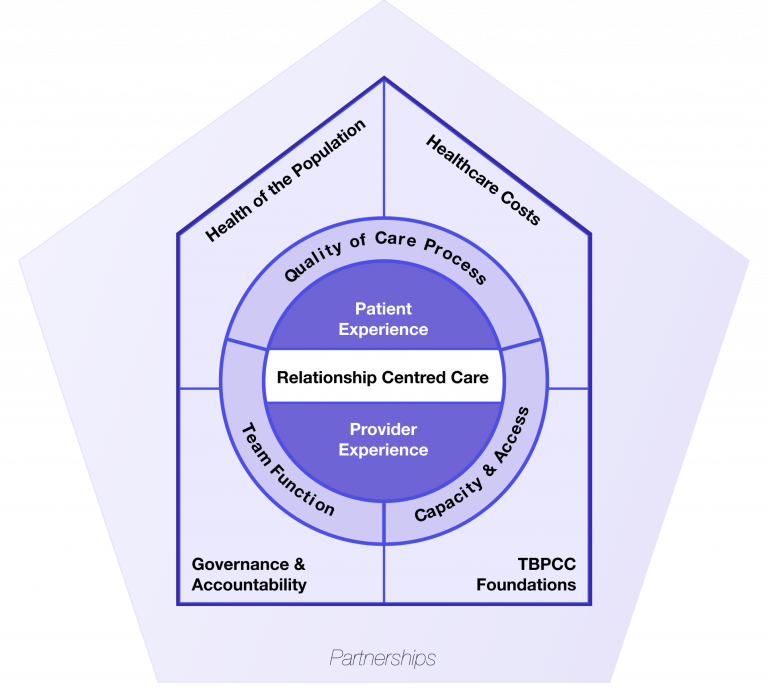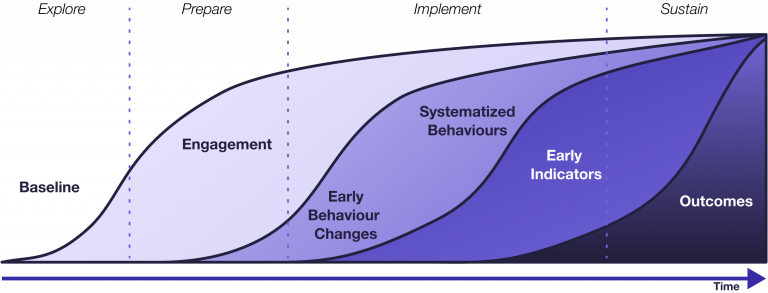We developed the Team-based care Evaluation and Adoption Model (TEAM) Framework1 to help the Ministry of Health and communities coordinate and plan primary and community care evaluation.
The TEAM Framework includes a 10-dimension Evaluation Model (Figure 1), outlining key concepts of team-based care (TBC), and an Adoption Model (Figure 2) to reflect the importance of both formative evaluation within projects and summative evaluation over time.

The Evaluation Model
The Evaluation Model includes 10 key dimensions for team-based care evaluation and is positioned on the backdrop of the WHO’s partnership pentagon2 to acknowledge the stakeholders involved in team-based care. The 10 dimensions include:
- Relationship Centred Care
- Patient Experience
- Provider Experience
- Team Function
- Quality of Care Process
- Capacity & Access
- Team-Based Primary and Community Care (TBPCC) Foundations
- Governance & Accountability
- Health of the Population
- Healthcare Costs
The Adoption Model
The Adoption Model highlights how to consider evaluation planning over time.

Evaluation plans should start with measuring baseline and early intention to change, continue with measuring observable behaviour and, finally measure long-term outcomes. The Adoption Model also incorporates the EPIS (Exploration, Preparation, Implementation and Sustainment) implementation framework3 to highlight the importance of considering a team’s stage of adoption when planning and implementing evaluation and quality improvement efforts.
Using the Team Framework
We encourage healthcare planners and leaders to use the TEAM Framework as a tool in their work! Some examples of how we have used the Framework include:
- Using the Framework to guide system-wide evaluation plans, including in the development of the Team-Based Primary Care Evaluation. The Framework helped to focus the evaluation planning to specific dimensions to measure.
- Developing a comprehensive indicator database from which we can pull specific evaluation questions or indicators when designing an evaluation. The TEAM Framework is the structure for the database which allows us to quickly and easily choose indicators that are the best metrics for each dimension.
- We have developed or suggested use of tools that support both quality improvement and learning on specific dimensions including the Team Effectiveness Tool on the teambasedcarebc.ca website, the CAMP Clinic Survey, and the initial work in the CHC Evaluation Pilot.
Resources
- Download this page as a shareable PDF.
- Watch the Team Up! webinar or listen to the Team Up! podcast discussion of the TEAM Framework.
For more information please contact Elka.Humphrys@ubc.ca.
References
- Fletcher SC, et al. Team-based care Evaluation and Adoption Model (TEAM) Framework. Canadian Family Physician, 2021. Available here. ↩︎
- Framework for action on interprofessional education and collaborative practice. World Health Organization; 2010. ↩︎
- Moullin JC, et al. Systematic review of the Exploration, Preparation, Implementation, Sustainment (EPIS) framework. Implementation Science, 2019. ↩︎